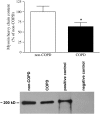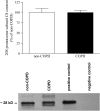Activation of the ubiquitin-proteasome pathway in the diaphragm in chronic obstructive pulmonary disease
- PMID: 16917114
- PMCID: PMC2648103
- DOI: 10.1164/rccm.200605-721OC
Activation of the ubiquitin-proteasome pathway in the diaphragm in chronic obstructive pulmonary disease
Abstract
Rationale: Studies show that the myosin content of the diaphragm in patients with mild to moderate chronic obstructive pulmonary disease (COPD) is reduced, compromising diaphragm contractile performance. The mechanisms for reduced contractile protein content are unknown. In the present study we hypothesized that the loss of contractile protein content is associated with activation of the ubiquitin-proteasome pathway in the diaphragm of patients with mild to moderate COPD.
Methods: Proteolytic activity of isolated 20S proteasomes was determined in diaphragm biopsies from patients with and without COPD (predicted mean FEV1, 66 and 93%, respectively). In addition, we determined 20S proteasome subunit C8 protein levels by means of Western blotting, ubiquitin-ligase mRNA levels by means of real-time polymerase chain reaction, and caspase-3 activity by determining the hydrolysis of fluorogenic substrates.
Results: The 20S proteasome activity was about threefold increased in the diaphragm of patients with COPD. C8 protein levels were not significantly different between COPD and non-COPD diaphragm, indicating increased specific activity of individual proteasomes, rather than an increased number of proteasomes. mRNA levels of the muscle-specific ubiquitin-ligase MAFbx were significantly higher in diaphragm from patients with COPD compared with patients without COPD. Caspase-3-mediated cleavage of actomyosin complexes is considered an initial step in muscle wasting, yielding fragments that can be degraded by the ubiquitin-proteasome pathway. In line with the increased ubiquitin-proteasome activity, caspase-3 activity was higher in diaphragm homogenates from patients with COPD.
Conclusions: The present study is the first to demonstrate increased activity of the ubiquitin-proteasome pathway in COPD diaphragm. Importantly, these changes occur in patients with only mild to moderate COPD (Global Initiative for Chronic Obstructive Lung Disease stage I/II).
Figures





Similar articles
-
Diaphragm dysfunction in chronic obstructive pulmonary disease.Am J Respir Crit Care Med. 2005 Jul 15;172(2):200-5. doi: 10.1164/rccm.200502-262OC. Epub 2005 Apr 22. Am J Respir Crit Care Med. 2005. PMID: 15849324 Free PMC article.
-
Inhibition of the ubiquitin-proteasome pathway does not protect against ventilator-induced accelerated proteolysis or atrophy in the diaphragm.Anesthesiology. 2014 Jul;121(1):115-26. doi: 10.1097/ALN.0000000000000245. Anesthesiology. 2014. PMID: 24681580 Free PMC article.
-
[The proteasome inhibitor MG132 attenuates skeletal muscle atrophy in a rat model of chronic obstructive pulmonary disease].Zhonghua Jie He He Hu Xi Za Zhi. 2013 Jun;36(6):441-6. Zhonghua Jie He He Hu Xi Za Zhi. 2013. PMID: 24103208 Chinese.
-
The role of E3 ubiquitin-ligases MuRF-1 and MAFbx in loss of skeletal muscle mass.Free Radic Biol Med. 2016 Sep;98:218-230. doi: 10.1016/j.freeradbiomed.2015.12.031. Epub 2015 Dec 29. Free Radic Biol Med. 2016. PMID: 26738803 Review.
-
The ubiquitin-proteasome system and skeletal muscle wasting.Essays Biochem. 2005;41:173-86. doi: 10.1042/EB0410173. Essays Biochem. 2005. PMID: 16250905 Review.
Cited by
-
Nitroproteins Identified in Human Ex-smoker Bronchoalveolar Lavage Fluid.Aging Dis. 2011 Apr;2(2):100-15. Epub 2010 Nov 8. Aging Dis. 2011. PMID: 22396869 Free PMC article.
-
Atrophy signaling pathways in respiratory and limb muscles of guinea pigs exposed to chronic cigarette smoke: role of soluble guanylate cyclase stimulation.Am J Physiol Lung Cell Mol Physiol. 2023 May 1;324(5):L677-L693. doi: 10.1152/ajplung.00258.2022. Epub 2023 Mar 7. Am J Physiol Lung Cell Mol Physiol. 2023. PMID: 36881560 Free PMC article.
-
Hypercapnia attenuates ventilator-induced diaphragm atrophy and modulates dysfunction.Crit Care. 2014 Feb 9;18(1):R28. doi: 10.1186/cc13719. Crit Care. 2014. PMID: 24506836 Free PMC article.
-
The role of Interleukin 15 in protein degradation in skeletal muscles in rats of chronic obstructive pulmonary disease.Int J Clin Exp Med. 2015 Feb 15;8(2):1976-84. eCollection 2015. Int J Clin Exp Med. 2015. PMID: 25932126 Free PMC article.
-
Removal of senescent cells reduces the viral load and attenuates pulmonary and systemic inflammation in SARS-CoV-2-infected, aged hamsters.Nat Aging. 2023 Jul;3(7):829-845. doi: 10.1038/s43587-023-00442-w. Epub 2023 Jul 6. Nat Aging. 2023. PMID: 37414987 Free PMC article.
References
-
- Laghi F, Tobin MJ. Disorders of the respiratory muscles. Am J Respir Crit Care Med 2003;168:10–48. - PubMed
-
- Gray-Donald K, Gibbons L, Shapiro SH, Macklem PT, Martin JG. Nutritional status and mortality in chronic obstructive pulmonary disease. Am J Respir Crit Care Med 1996;153:961–966. - PubMed
-
- Similowski T, Yan S, Gauthier AP, Macklem PT, Bellemare F. Contractile properties of the human diaphragm during chronic hyperinflation. N Engl J Med 1991;325:917–923. - PubMed
-
- Cassart M, Pettiaux N, Gevenois PA, Paiva M, Estenne M. Effect of chronic hyperinflation on diaphragm length and surface area. Am J Respir Crit Care Med 1997;156:504–508. - PubMed
-
- Orozco-Levi M, Lloreta J, Minguella J, Serrano S, Broquetas JM, Gea J. Injury of the human diaphragm associated with exertion and chronic obstructive pulmonary disease. Am J Respir Crit Care Med 2001;164: 1734–1739. - PubMed
Publication types
MeSH terms
Substances
Grants and funding
LinkOut - more resources
Full Text Sources
Other Literature Sources
Medical
Research Materials

